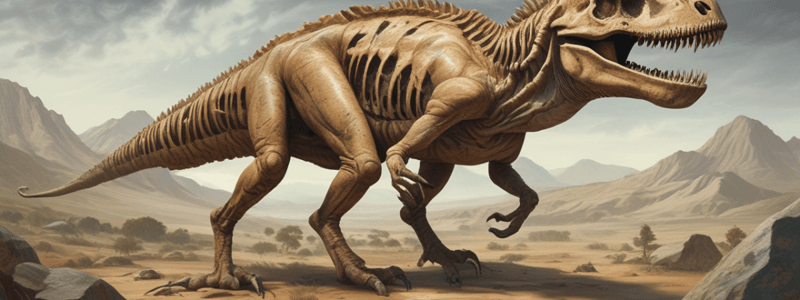Podcast
Questions and Answers
What is the process called when minerals or sediments fill the empty space of a mold and solidify?
What is the process called when minerals or sediments fill the empty space of a mold and solidify?
- Fossilization
- Carbonization
- Permineralization
- Casting (correct)
Which type of fossil preserves detailed internal and external structures of the original organism?
Which type of fossil preserves detailed internal and external structures of the original organism?
- Carbonized Fossils
- Permineralized Fossils (correct)
- Amber Fossils
- Mold Fossils
What is unique about Amber Fossils?
What is unique about Amber Fossils?
- They display fine details of the organism's structure
- They provide detailed internal structures
- They are typically flat
- They preserve organisms in remarkable detail (correct)
What is the primary difference between Body Fossils and Trace Fossils?
What is the primary difference between Body Fossils and Trace Fossils?
What do Carbonized Fossils typically display?
What do Carbonized Fossils typically display?
What is the primary characteristic of body fossils?
What is the primary characteristic of body fossils?
Which type of fossil is formed when an organism interacts with a substrate?
Which type of fossil is formed when an organism interacts with a substrate?
What is the main difference between mold fossils and cast fossils?
What is the main difference between mold fossils and cast fossils?
Which type of fossil provides evidence of an organism's behavior, movement, and interactions with its environment?
Which type of fossil provides evidence of an organism's behavior, movement, and interactions with its environment?
What happens to the original material in the formation of mold fossils?
What happens to the original material in the formation of mold fossils?
Flashcards are hidden until you start studying
Study Notes
Types of Fossils
- Body Fossils: actual physical remains of an organism (e.g., bones, teeth, shells, leaves) that form when an organism's hard parts are rapidly buried and mineralized, providing direct evidence of an organism's structure and appearance.
- Trace Fossils (Ichnofossils): record the activities of organisms (e.g., footprints, burrows, coprolites) that form when an organism interacts with a substrate, providing indirect evidence of an organism's behavior, movement, and interactions with its environment.
Mold Fossils and Cast Fossils
- Mold Fossils: impressions left in the substrate where an organism was buried, capturing the external shape and surface details of the organism but not containing any original material.
- Cast Fossils: created when a mold is filled with sediment or mineral deposits that harden into the shape of the original organism, providing a three-dimensional representation of the organism's external features.
Permineralized Fossils and Amber Fossils
- Permineralized Fossils: form when minerals precipitate into the pores of an organism's remains (e.g., bones, wood), preserving its internal and external structures in great detail.
- Amber Fossils: organisms or parts of organisms preserved in tree resin that hardened into amber, often preserving soft tissues and coloration.
Carbonized Fossils
- Carbonized Fossils: form when organic material is compressed and leaves a carbon imprint on rock, typically displaying fine details of the organism's structure.
Comparison and Contrast of Fossil Types
- Nature of Preservation: each type of fossil preserves different aspects of ancient life (e.g., body fossils preserve actual remains, trace fossils preserve evidence of activity).
- Information Provided: each type of fossil provides unique insights into the history of life on Earth (e.g., body fossils provide anatomical information, trace fossils reveal behavior).
- Formation Processes: different fossils form through distinct processes involving preservation conditions, mineralization, and environmental factors.
- Detail and Quality: each type of fossil provides varying levels of detail and quality of preservation (e.g., amber fossils can preserve exceptional detail, while mold and cast fossils typically preserve only external features).
- Applications: each type of fossil has unique applications in fields such as anatomy, behavioral studies, and biological and ecological research.
Studying That Suits You
Use AI to generate personalized quizzes and flashcards to suit your learning preferences.




